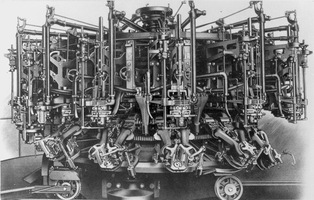 | Back to e-WV
| Back to e-WV
 The West Virginia Encyclopedia
The West Virginia Encyclopedia
 | Back to e-WV
| Back to e-WV
 The West Virginia Encyclopedia
The West Virginia Encyclopedia

The Owens-Illinois Glass Company, based in Toledo, Ohio, operated three glass factories in West Virginia. These factories were located in Fairmont, Huntington, and Kanawha City. All three based their manufacturing operations on the revolutionary Owens bottle-making machine. This machine was invented by West Virginia native Michael Owens in 1903, with the financial backing of glass manufacturer Edward Libbey. The success of this machine led to the establishment of the Owens Bottle Machine Company. As the company grew, the name was changed to the Owens Bottle Company in 1919. In 1929, the Owens Bottle Company merged with Illinois Glass Company to become Owens-Illinois.
Owens-Illinois Glass Company opened in Fairmont in November 1910 as the Owens Bottle Works. The factory was built on 40 acres on the east side of Fairmont. When production began, the plant ran 24 hours a day and employed about 200 workers. This plant had six furnaces as well as six of Michael Owens’s bottle machines, producing a total of 180,000 bottles per day. Over the years production grew steadily at the Fairmont factory, and by the 1970s more than 1,000 people were employed there. But in 1978, Owens-Illinois began phasing out operations at the Fairmont plant. Nearly 700 people were laid off from their jobs by 1980. In March 1982, the plant closed.
In 1914, Charles Boldt started manufacturing glass in Huntington, in the southwest section of the city. The factory began with three furnaces and two of Michael Owens’s bottle machines. In 1918, Owens-Illinois purchased the Huntington factory. The Huntington Division employed more than 1,100 people by 1947 and had expanded to five furnaces. The name of the plant was later changed to the Glass Container Division of Owens-Illinois. The operation had made billions of glass containers by 1971. However, during the 1980s glass production at the plant began to decline. When the Huntington factory closed in 1993, the last 650 workers were laid off.
In 1917, the Owens Bottle Company opened a plant at the upper end of Kanawha City, which is now part of Charleston. The bottling plant was built across the street from a related enterprise, the Libbey-Owens-Ford sheet glass plant which was constructed in 1916. The bottle factory produced fruit jars, jars for industrial products, and after the end of Prohibition, beer bottles. By the 1930s, the Kanawha City plant was the largest bottle-making factory in the world. However, production declined in the 1950s and the factory closed its doors in 1963. The former glass factory site is now part of a shopping center.
Written by Christy Venham